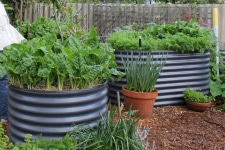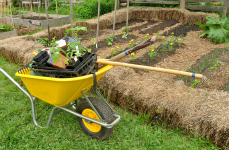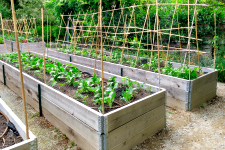A raised garden bed is one that has had the sides built up out of timber, straw or even metal and it can be between 30cm and 90cm high. It’s a terrific way to grow a vegetable garden in a difficult spot such as on clay soil that is hard to dig or on concrete. It also makes gardening really easy because you don’t have to bend over so much, the soil is really good quality and there are not as many weeds.
CHOOSE THE TYPE OF RAISED GARDEN BED
Water tanks that don’t have a base make fantastic raised garden beds. They come in all sorts of shapes, sizes and colours and can be bought from hardware stores and garden centres. Their edges are rolled over so they are very safe and they last for many years.
Raised beds can also be made out of long lengths of hardwood timber that are held into place with brackets and stakes hammered into the ground. You can also buy timber kits which are really easy to put together. Don’t use treated pine as the chemical in it leaches into the soil and possibly into the vegetables.
Even bales of straw can be used to build the walls of a raised garden bed. Just lay them down like giant Lego blocks. After many months when they start to break down they can be pulled apart and spread on the garden as mulch.
PREPARING AND PLANTING THE BED
- Choose a spot for a raised garden bed that gets at least 6 hours of direct sunlight and has access to a hose or, even better, a reticulation system. It should sit on level ground and have enough room around it to walk and push a wheelbarrow.
- Clear most of the weeds from the area. If there is grass in that spot, ask an adult to either dig it out or spray it with a herbicide to kill it. Or, you could try putting extra thick newspaper over the grass when doing the next step.
- Put the raised garden bed into position then line the base with a layer of cardboard or a layer of newspaper that is at least 1cm thick. This will stop any weeds from coming through.
- If the garden bed is less than 50cm high, fill the whole thing with a good quality vegetable mix from the local landscape supplier. If it taller, save some money by filling the bottom half with organic material such as lawn clippings, straw, shredded paper, kitchen scraps, shredded garden material and compost. Then, put the vegetable mix from the landscape supplier on the top.
- Dig a few bags of compost or animal manure through the vegetable mix to give it an extra boost. Make sure that the soil is at least 5cm lower than the edge of the bed.
- Water the soil really well before planting and plan where all the seedlings will be planted. If a trellis is needed for climbing plants, build it now before planting.
- Use a dibbler or fat stick to make holes for the seedlings and start planting.
- Once the seedlings have been planted, sprinkle controlled release fertiliser for vegetables around each seedling. This will slowly release nutrients to help them grow.
- Spread a layer of lucerne hay over the top as a mulch. Water the soil again so that everything settles in nicely.
TEACHERS: When building a raised garden bed at school, try to avoid setting one up in an area such as bitumen because heat will reflect off the ground in summer and get very hot causing the plants to struggle. Calculating the capacity of the bed to find out how much soil is needed is a great classroom activity.



